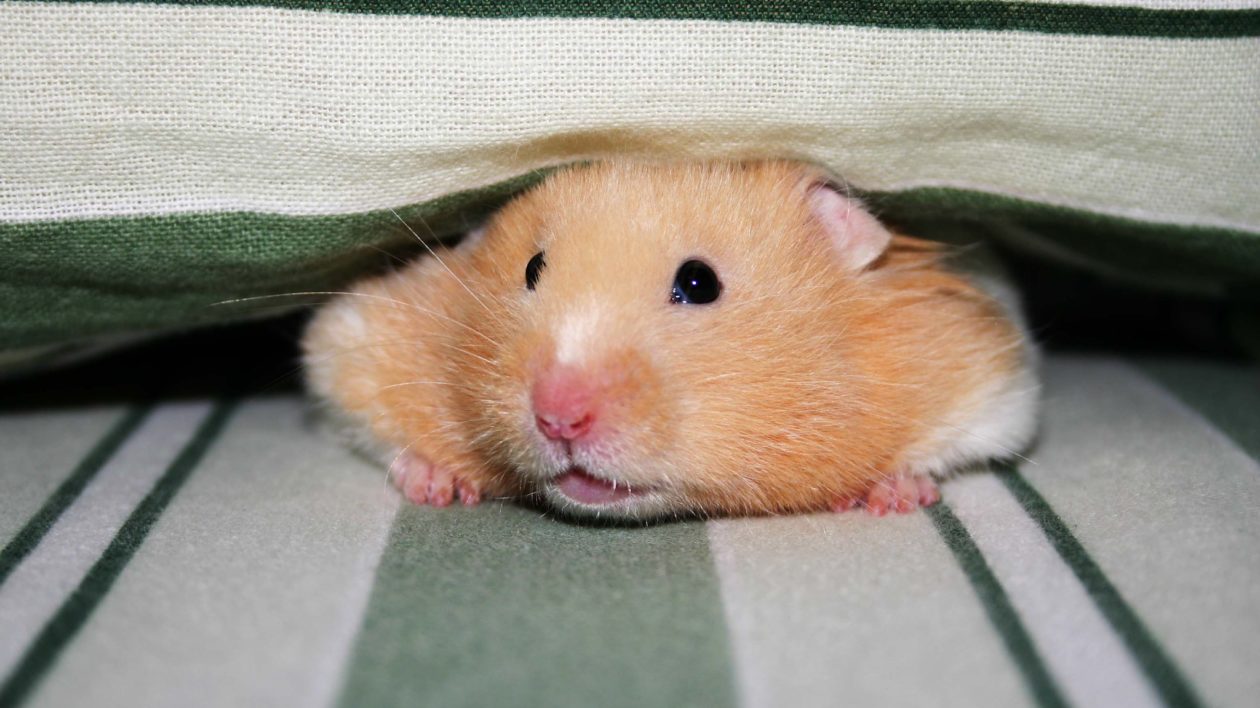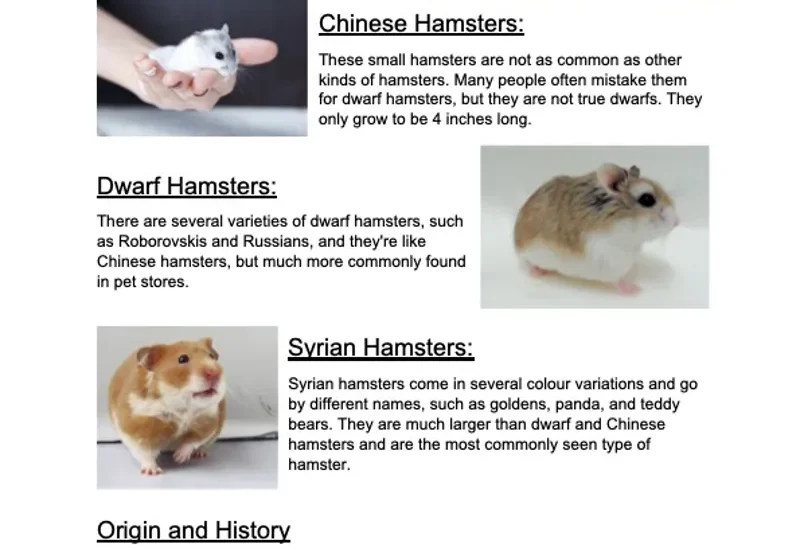History of Hamster Breeds
Origins of Hamster Breeds
The history of hamster breeds can be traced back to the early 19th century when the golden hamster was first discovered in Syria. Due to their fascinating traits and unique behaviors, hamsters quickly became popular among pet enthusiasts. Different hamster breeds emerged over time, each with distinct characteristics. For example, the Campbells dwarf hamster was first recognized in the 1990s, showcasing how selective breeding has led to greater diversity in pet hamsters.

Early Discoveries
The golden hamster, initially discovered by zoologist Aaron A. Eucharis, was brought to Europe in 1930. This marked the beginning of hamster domestication, leading to the establishment of various hamster types. As they became popular pets in Europe, their breeding was refined, leading to a wide variety of hamster breeds. In their natural habitat, these creatures exhibit a range of colors and sizes that are often highlighted in selective breeding. The growth of the pet industry further propelled the demand for unique hamster breeds.
Standards and Recognitions
As breeders increased their efforts, established standards for various hamster breeds began to emerge. Organizations like the National Hamster Council in the UK created guidelines to ensure healthy breeding practices. This emphasis on ethics not only maintained the well-being of hamster breeds but also promoted biodiversity among pet hamsters. Consequently, breeders could focus on enhancing specific traits, allowing them to produce hamsters that appealed to pet owners. Today, many breeds are recognized worldwide, each with a dedicated following.
Diverse Hamster Breeds Today
Today, there are several popular hamster breeds, each possessing distinct aesthetic and behavioral traits. The most recognized breeds include the Syrian, dwarf, and Roborovski hamsters. These breeds not only differ in size and color but also in their social behaviors, which can significantly impact the experience of pet ownership.

The Syrian Hamster: The Most Popular Breed
The Syrian hamster, known for its docile temperament, is often suggested for beginners. With their fluffy fur and larger size, they generally weigh between 5 and 7 ounces. Unlike dwarf hamsters, Syrians should be kept alone due to their territorial nature. This breed has multiple color variations, including golden, cream, and black. Their popularity has ensured a continued demand for breeding as pet enthusiasts seek out the perfect companion.
Dwarf Hamsters: Small but Mighty
Dwarf hamsters, such as the Campbell’s and Winter White, are notable for their reduced size and friendly demeanor. Weighing around 2 ounces on average, these tiny creatures are social and can live together when introduced at a young age. They are often recognized for their vibrant coat colors and patterns. Understanding their unique needs, including habitat requirements and social dynamics, is crucial for potential owners.
Hamster Breeding Practices
Selective breeding has played a significant role in the history of hamster breeds, allowing breeders to enhance specific traits such as color, fur texture, and behavior. Understanding the implications of breeding is vital to ensure healthy populations of hamsters. Ethical breeding practices are essential to preventing health issues that can arise from inbreeding.

Selective Breeding and Genetic Diversity
Selective breeding involves choosing specific hamsters to mate based on desired traits. This process can lead to beautifully diverse markings or specific size categories. However, it’s essential to maintain genetic diversity to prevent health issues. Knowledge about genetics can help breeders understand how to reduce the risk of inherited diseases while still producing desirable traits. It’s also crucial to ensure that breeding practices adhere to ethical standards.
The Impact of Human Intervention
Human intervention in hamster breeding has both positive and negative consequences. On one hand, intentional breeding has led to the emergence of unique and friendly breeds. On the other hand, some practices may prioritize aesthetics over health. Pet owners should be cautious of breeders who do not prioritize the welfare of their hamsters, leading to offspring with genetic disorders. Education and awareness can help pet enthusiasts make informed decisions about their future pets.
The Importance of Responsible Ownership
Understanding the history and differences among hamster breeds is only part of the journey for potential pet owners. Responsible ownership, which includes proper care and ethical treatment, is necessary to ensure a fulfilling bond between humans and hamsters. Learning about hamster behavior, habitat needs, and social dynamics can equip owners with the knowledge required for successful pet upbringing.

Creating a Suitable Habitat
To ensure a thriving environment for hamsters, owners should be prepared to provide adequate space, bedding, and enrichment. Syrian hamsters require larger cages that allow them to roam and explore, while dwarf hamsters can thrive in more compact spaces but still need plenty of stimulation. Utilizing tunnels, wheels, and hideouts can help cater to their natural instincts. Moreover, maintaining cleanliness in their habitats will contribute to their overall health and happiness.
Understanding Hamster Behavior
Hamsters are naturally solitary animals, and understanding their behavior can be crucial for forming a bond. Each breed exhibits different levels of friendliness and activity. Taking the time to train and socialize with hamsters at a young age can encourage a more trusting relationship. Moreover, exhibiting patience and knowing when to give them space is essential to prevent stress or discomfort.
Key Takeaways
- The history of hamsters dates back to the 19th century with the golden hamster’s discovery.
- Distinct hamster breeds have unique traits, including differences in behavior and appearance.
- Responsible breeding practices are integral to maintaining hamsters’ health and genetic diversity.
- Creating a suitable habitat and understanding behavior is vital for owners to ensure pet well-being.
- Awareness of ethical breeding practices promotes healthier hamster populations and informed ownership.
FAQ
1. What is the most common type of hamster breed?
The most common hamster breed is the golden hamster, also known as the Syrian hamster. These hamsters are favored due to their gentle dispositions and large size, making them excellent pets for families and individuals alike.
2. How do hamster breeds differ in care requirements?
Different hamster breeds may have unique care needs based on their size and social dynamics. For instance, Syrian hamsters generally need larger cages and should be kept alone, whereas dwarf hamsters can thrive in smaller spaces and may live together in pairs, granted they are introduced early.
3. Are there specific health concerns related to certain hamster breeds?
Yes, some hamster breeds can be predisposed to specific health issues due to genetic factors. For instance, dwarf hamsters might experience diabetes, while Syrians may face tumors as they age. Regular health check-ups and proper diets can help reduce such risks.
4. What should I consider when choosing a hamster breed?
When selecting a hamster breed, consider factors like temperament, size, and social behavior. For instance, beginners may prefer the Syrian hamster due to its docile nature, while those looking for social pets might choose dwarf hamsters.
5. How can I promote a healthy environment for my hamster breed?
To create a healthy environment for your hamster, ensure you provide ample space, proper bedding, and enrichment activities like exercise wheels, tunnels, and chew toys. It’s also essential to maintain cleanliness and regulate temperature to keep them comfortable.
